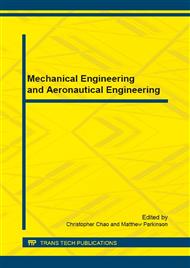p.29
p.35
p.41
p.46
p.55
p.61
p.66
p.73
p.78
CDM Approach Applied to Crack Initiation and Propagation under Variable Amplitude
Abstract:
In this paper, the low cycle fatigue crack initiation life was regarded as a process of damage accumulation and a damage accumulation model was established based on the Continuum Damage Mechanics. By the model, we analyzed how the variable amplitude applied at the crack initiation stage influenced the low cycle fatigue life of high temperature materials. With the parameters of GQGH4169 alloy at room temperature, we determined the specific values of damage parameters by finite element method and numerical analysis method. Then, the crack initiation life predictions were carried out. The results show that using this approach can not only predict the crack initiation life of CT specimen accurately, but also reflect a definite influence of variable amplitude on the crack propagation life combining with the Paris Law, and the test costs reduced consequently.
Info:
Periodical:
Pages:
55-60
Citation:
Online since:
March 2016
Authors:
Price:
Сopyright:
© 2016 Trans Tech Publications Ltd. All Rights Reserved
Share:
Citation:


